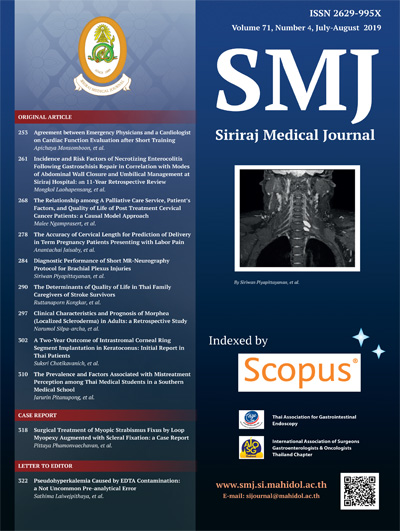Diagnostic Performance of Short MR-Neurography Protocol for Brachial Plexus Injuries
Keywords:
MR-neurography; high-resolution MRI; brachial plexus injury; nerve root avulsionAbstract
Objective: To study the diagnostic performance of MR neurography (MRN) for brachial plexus injuries and to optimize the protocol using clinical contexts as the reference standard.
Methods: There were 21 patients with brachial plexus injury who were scheduled for conventional myelography. A brachial plexus MRN including T2-weighted image-high resolution (T2WI/HR), mDIXON and diffusion weighted image was performed prior to a conventional myelography on the same day. The results of the conventional
myelography and the MR imaging were recorded and compared, with the clinical contexts as the reference standard. The sensitivities, specificities, accuracies, false positive and false negative were calculated and compared.
Results: The accuracy, sensitivity, specificity, false positive and false negative of the conventional myelography were 69.52%, 73.61%, 60.61%, 19.70% and 48.72%, respectively. The diagnostic performance of T2WI/HR were 72.00%, 78.26%, 58.06%, 19.40% and 45.45% for T2WI/HR, respectively which were comparable to those of conventional myelography. The accuracy, sensitivity, specificity, false positive and false negative of the combination of T2WI/HR and mDIXON were 78.00%, 97.10%, 35.48%, 22.99% and 15.38%, respectively which yielded the highest accuracy.
Conclusion: MRN with the combination of T2WI/HR and mDIXON was superior to conventional myelography for the evaluation of brachial plexus injuries due to its shorter processing time, the lack of a need for contrast medium administration, its noninvasive nature, and the provision of information about both preganglionic and
postganglionic injuries.
Downloads
Published
How to Cite
Issue
Section
License

This work is licensed under a Creative Commons Attribution-NonCommercial-NoDerivatives 4.0 International License.
Authors who publish with this journal agree to the following conditions:
Copyright Transfer
In submitting a manuscript, the authors acknowledge that the work will become the copyrighted property of Siriraj Medical Journal upon publication.
License
Articles are licensed under a Creative Commons Attribution-NonCommercial-NoDerivatives 4.0 International License (CC BY-NC-ND 4.0). This license allows for the sharing of the work for non-commercial purposes with proper attribution to the authors and the journal. However, it does not permit modifications or the creation of derivative works.
Sharing and Access
Authors are encouraged to share their article on their personal or institutional websites and through other non-commercial platforms. Doing so can increase readership and citations.











